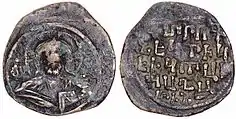Kiurikian dynasty
The Kiurikian or Kiurikid dynasty (Armenian: Կյուրիկյաններ or more rarely Gurgenian, Armenian: Գուրգենյաններ) was a medieval Armenian royal dynasty which ruled the kingdoms of Tashir-Dzoraget (978-1118) and Kakheti-Hereti (1029/1038-1105). They originated as a junior branch and vassals of the Bagratid dynasty, but outlived the main branch of the dynasty after the fall of the Bagratid Kingdom of Armenia. They became vassals of the Seljuk Turks in the second half of the 1060s. After the fall of the Kingdom of Tashir-Dzoraget to the Seljuks in the early 12th century, members of the dynasty continued to rule from their fortresses of Tavush, Matsnaberd and Nor Berd until the 13th century.
| Kiurikian | |
|---|---|
 | |
| Parent house | Bagratuni dynasty |
| Country | Armenia, Georgia |
| Founded | c. 970 |
| Founder | Kiurike I |
| Titles | |
History

.jpg.webp)
The Kiurikian dynasty and the Kingdom of Tashir-Dzoraget (also known as the Kingdom of Lori) were founded by Kiurike (a variation of the name Gurgen), youngest son of the Bagratid king of Armenia Ashot III the Merciful.[1]
Information about Kiurike I is very scarce. It is known that in 974 he participated in the mobilization of Armenian troops initiated by his father Ashot III, during the time of Byzantine Emperor John Tzimiskes' campaign in Asia Minor, which posed a threat to the southern borders of Armenia.[1] Kiurike received the title of "King of Tashir-Dzoraget", in the northern part of the Bagratid Kingdom of Armenia, after the death of his father in 977. He continued work on the construction of the monastic complexes of Sanahin and Haghpat, as evidenced by his donation to the Sanahin monastery of two large and luxurious chandeliers. He also participated in the campaign of his brother King Smbat II against the King of Abkhazia Bagrat II (who later ruled Georgia as Bagrat III), in defense of the ruler of Tao David III.[2]
After the death of Smbat II under dubious circumstances, Kiurike's middle brother Gagik I ascended to the throne. Gagik reaffirmed his younger brother Kiurike's royal rights on the condition of loyalty to the new king. The last time Kiurike is mentioned in the primary sources is in 991. According to an unnamed 12th-century chronicler, Kiurike ruled for 10 years (which is consistent with the dating of his coronation to 981 by the historian Mekhitar of Ayrivank). Described as an extremely devout man, he abdicated the throne of in favor of his son David I and devoted the last 8 years of his life to spiritual matters at Sanahin Monastery.[3]
The kingdom of the Kiurikians reached its highest peak under David I the Landless (r. 989-1048) and his son Kiurike II (r. 1048-1089)․[3] David's activities are recorded in the Universal History of the 11th century Armenian historian Stepanos Asoghik.[4] As a result of his successful wars against the neighboring emirates of Tiflis (Tbilisi) and Ganja, David significantly expanded the boundaries of his kingdom.[5] In the mid-990s, he annexed Dmanisi, defeated the emir of Tiflis Ali ibn Jafar in battle and forced the latter to accept the Kiurikians' suzerainty. With this victory, David strengthened the security of the northern borders of the Armenian kingdom.[3]
Before 1001, David faced another threat, this time from the southeast, namely the Emirate of Ganja, where the Kurdish Shaddadid dynasty was established in the 970s. Especially under Emir Fadl I (r. 985-1031), the emirate tried to prevent the further rise of the Kiurikid kingdom. However, when Fadl I attacked David, apparently off the banks of the Kura River, he suffered a heavy defeat and fled from the battlefield. David, though unable to build on this victory and expand the boundaries of his kingdom, temporarily eliminated the threat posed by the Emir of Ganja.[3]
After that, David had to pacify a rebellion by his vassal Demetre, lord of the fortress of Gag (Gaga Berd). The latter renounced the Armenian Church and converted to Chalcedonism, apparently with the aim of enlisting the support of Georgia and gaining independence from the Kiurikids. In addition, Demetre appointed his son, who had also converted to Chalcedonianism, as Archbishop of Tashir at Hnevank Monastery. David suppressed the rebellion of the prince and deprived him of Gaga Berd and all his other possessions.[3]
In 1001, David made an unsuccessful attempt to achieve complete independence from the Bagratid Kingdom of Armenia, which was brutally suppressed by his uncle King Gagik I.[2][6] David lost almost all of his possessions (for which he was nicknamed "the Landless") and was able to regain them only after recognizing the supremacy of the king in Ani.[6]
For the next two decades, nothing concrete is known about David's activities. During this period he was likely busy strengthening the defenses of his kingdom, which resulted in the founding of the fortress of Lori (which would later become the capital of the kingdom) and 12 other fortresses. Based on these extension construction projects, it can be assumed that this was the period of economic prosperity for the Kingdom of Tashir-Dzoraget.[3]
References
- "Gurgen". Armenian Soviet Encyclopedia (in Armenian). vol. 3. Yerevan. 1977. p. 256.
- Stepanenko, V. P. (1978). "Из истории армяно-византийских отношений второй половины X—XI в. (к атрибуции монет Кюрикэ куропалата)" [From the history of Armenian-Byzantine relations of the second half of the X-XI centuries. (on the attribution of coins of Kiurike Kouropalates)] (PDF). Античная древность и средние века (in Russian) (15): 43–51.
- Shahnazaryan, Artashes (2009). "Տաշիր-Ձորագետի Կյուրիկյան թագավորության առաջացումն ու հզորացումը" [The founding and strengthening of the Kiurikian kingdom of Tashir-Dzoraget]. Պատմա-Բանասիրական Հանդես (in Armenian) (2–3): 224–233. ISSN 0135-0536.
- Stepanos Asoghik (1864). Всеобщая история Степ'аноса Таронского, Асох'ика по прозванию [Universal History of Stepanos Taronetsi, also known as Asoghik]. Book 3, part 2. Translated by Emin, Mkrtich (Nikita Osipovich). Moscow. pp. 184–185.
- Zhukov, E. M. (ed.). "Ташир-дзорагетское царство". Soviet Historical Encyclopedia (in Russian). 14. Мoscow. p. 156.
- "Davit Anhoghin". Armenian Soviet Encyclopedia (in Armenian). vol. 3. Yerevan. 1977. p. 302.